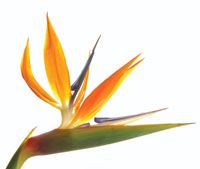Plant pigmentation
The presence of an ?animal-only? pigment, bilirubin, has been confirmed in the Bird of Paradise flower.

The presence of an “animal-only” pigment, bilirubin, has been confirmed in the Bird of Paradise flower. A study published in the American Society for Horticultural Science’s journal HortScience, has provided new insights into colour production in this iconic tropical plant.1
The Bird of Paradise plant, known for the distinctive shape of its orange and blue flowers, produces black seeds with vivid orange covering. The colour of this covering can remain unchanged for decades after the plant dies. This study used high performance liquid chromatography (HPLC) and HPLC–electrospray ionization–tandem mass spectrometry to show that the primary pigment of these arils was bilirubin, the yellowish hue normally associated with bruises and jaundice sufferers.
The study also tested to see whether the bright orange of the flowers was due to bilirubin. However, while its presence was detected in the vibrant sepals, the researchers concluded that the low concentrations made it unlikely that it contributed significantly to the colouring.
“This research is the first discovery of bilirubin in a flower,” said the researchers. “With further research on the function, distribution and synthesis of bilirubin in plants, the information may be useful for practical applications such as the manipulation of colour through breeding and genetics.”
1. C. Pirone et al., HortScience, 45(9), 1411–1415 (2010).
This story originally appeared in The Column. Click here to view that issue.

Regulatory Deadlines and Supply Chain Challenges Take Center Stage in Nitrosamine Discussion
April 10th 2025During an LCGC International peer exchange, Aloka Srinivasan, Mayank Bhanti, and Amber Burch discussed the regulatory deadlines and supply chain challenges that come with nitrosamine analysis.











